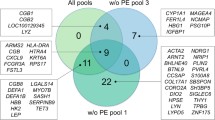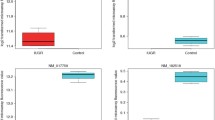Abstract
Objective
Third-trimester human placentas from normal and preeclamptic pregnancies were evaluated for possible changes in gene expression patterns by microarray analysis.
Methods
Placentas from four normal pregnancies and four pregnancies complicated by preeclampsia were studied. In a preliminary effort to identify possible differences between the two groups, complementary DNA (cDNA) probes were prepared from pooled total RNA by reverse transcription in the presence of 33P-dCTP. After hybridization to human GeneFilter cDNA microarrays (GF211; Research Genetics, Huntsville, AL), 319 positive signals were detected above background out of a possible 4131 human cDNAs spotted on the filters.
Results
Ten most highly expressed mRNA species, ten most up-regulated, and ten most down-regulated genes in placentas from both groups of patients were identified for future studies. Of the 319 positive hybridizations, one transcript was clearly elevated in preeclamptic pregnancy. This cDNA encodes the muscle subtype of glycogen Phosphorylase (GP-M) and was increased more than 2.8-fold (P <.05) in the preeclamptic placentas. In contrast, cDNA for glycogen synthase (muscle and liver isoforms) was not significantly increased, being near the limits of detection. The preeclampsia-induced increase of placental GP-M mRNA expression (approximately 3.5-fold) was confirmed by northern blot analysis.
Conclusion
We conclude that microarray analysis can detect trends in mRNA and gene expression in placentas from normal and preeclamptic pregnancies that may be further studied in a more targeted fashion. We found that placental GP-M mRNA level is up-regulated in preeclampsia, which is consistent with previous reports of increased glycogen Phosphorylase activity, and we suggest that it may be largely regulated at the level of transcription. Further studies may determine whether such up-regulation might be a response to hypoxia.
Similar content being viewed by others
References
van Beck E, Peeters LL. Pathogenesis of preeclampsia: A comprehensive model. Obstet Gynecol Surv 1998;53:233–9.
Dekker GA, Sibai BM. Etiology and pathogenesis of preeclampsia: Current concepts. Am J Obstet Gynecol 1998;179:1359–75.
Arngrimsson R, Bjornsson S, Geirsson RT, Bjornsson H, Walker JJ, Snaedal G. Genetic and familial predisposition to eclampsia and pre-eclampsia in a defined population. Br J Obstet Gynecol 1990;97:762–9.
Cooper DW, Brennecke SP, Wilton AN. Genetics of preeclampsia. Hypertens Pregn 1993;12:1–23.
Morgan T, Ward K. New insights into the genetics of preeclampsia. Semin Perinatol 1999;23:14–23.
Sgroi DC, Teng S, Robinson G, LeVangie R, Hudson JR Jr, Elkahloun AG. In vivo gene expression profile analysis of human breast cancer progression. Cancer research 1999;59:5656–61.
Huang H, Colella S, Kurrer M, Yonekawa Y, Kleihues P, Ohgaki H. Gene expression profiling of low-grade diffuse astrocytomas by cDNA arrays. Cancer Res 2000;60:6868–74.
Eckmann L, Smith JR, Housley MP, Dwinell MB, Kagnoff MF. Analysis by high density cDNA arrays of altered gene expression in human intestinal epithelial cells in response to infection with the invasive enteric bacteria Salmonella. J Biol Chem 2000;275: 14084–94.
Yowe D, Cook WJ, Gutierrez-Ramos JO. Microarrays for studying the host transcriptional response to microbial infection and for the identification of host drug targets. Microbes Infect 2001; 3:813–21.
McCormick SM, Eskin SG, McIntire LV, et al. DNA microarray reveals changes in gene expression of shear stressed human umbilical vein endothelial cells. Proc Natl Acad Sci U S A 2001;98: 8955–60.
Chen BP, Li YS, Zhao Y, et al. DNA microarray analysis of gene expression in endothelial cells in response to 24-h shear stress. Physiol Genomics 2001;7:55–63.
Muhle RA, Pavlidis P, Grundy WN, Hirsch E. A high-throughput study of gene expression in preterm labor with a subtractive microarray approach. Am J Obstet Gynecol 2001;185:716–24.
Bocco JL, Panzetta G, Flury A, Patrito LC. Expression of pregnancy specific beta 1-glycoprotein gene in human placenta and hydatidiform mole. Biochem Int 1989;18:999–1008.
Wang W, Xue Y, Zhou S, Kuo A, Cairns BR, Crabtree GR. Diversity and specialization of mammalian SWI/SNF complexes. Genes Dev 1996;10:2117–30.
Peterson CL, Tamkun JW. The SWI-SNF complex: A chromatin remodeling machine? Trends Biochem Sci 1995;20:143–6.
Sudarsanam P, Winston F. The Swi/Snf family nucleosome-remodeling complexes and transcriptional control. Trends Genet 2000;16:345–51.
Mandart E, Parker R. Effects of mutations in the Saccharomyces cerevisiae RNA14, RNA15, and PAP1 genes on polyadenylation in vivo. Mol Cell Biol 1995;15:6979–86.
Gautschi M, Lilie H, Funfschilling U, et al. RAC, a stable ribosome-associated complex in yeast formed by the Dnak-Dna J homologs Ssz1p and zuotin. Proc Natl Acad Sci USA 2001;98: 3762–7.
Braun A, Aszodi A, Hellebrand H, Berna A, Fassler R, Brandau O. Genomic organization of profiling-III and evidence for a transcript expressed exclusively in testis. Gene 2002;283:219–25.
Schneider H, Challier JC, Dancis J. Transfer and metabolism of glucose and lactate in the human placenta studied by a perfusion system in vitro. Placenta 1981;2(Suppl):129–38.
Bloxam DL. Human placental energy metabolism: Its relevance to in vitro perfusion. Contrib Gynecol Obstet 1985;13:59–69.
SoothiU PW, Nicolaides KH, Rodeck CH, Campbell S. Effect of gestational age on fetal and intervillous blood gas and acid-base values in human pregnancy. Fetal Ther 1986;1:168–75.
Tsoi SC, Zheng J, Xu F, Kay HH. Differential expression of lactate dehydrogenase isozymes (LDH) in human placenta with high expression of LDH-A4 isozyme in the endothelial cells of pre-clampsia villi. Placenta 2001;22(4):317–22.
Gratton RJ, Gandley RE, Genbacev O, McCarthy JF, Fisher SJ, McLaughlin MK. Conditioned medium from hypoxic cytotro-phoblasts alters arterial function. Am J Obstet Gynecol 2001; 184(5):984–90.
Arkwright PD, Rademacher TW, Dwek RA, Redman CW. Pre-eclampsia is associated with an increase in trophoblast glycogen content and glycogen synthase activity, similar to that found in hydatidiform moles. J Clin Invest 1993;91:2744–53.
Schena M, Shalon D, Davis RW, Brown PO. Quantitative monitoring of gene expression patterns with a complementary DNA microarray. Science 1995;270:467–70.
Author information
Authors and Affiliations
Additional information
Supported in part by HD2456 and a grant from the Meriter Foundation, Madison, Wisconsin.
The authors are grateful to Dr. Ronald Magness for assistance in writing the manuscript and to Jing Zheng for assistance with Statistical analysis.
Rights and permissions
About this article
Cite this article
Tsoi, S.C.M., Cale, J.M., Bird, I.M. et al. cDNA Microarray Analysis of Gene Expression Profiles in Human Placenta: Up-Regulation of the Transcript Encoding Muscle Subunit of Glycogen Phosphorylase in Preeclampsia. Reprod. Sci. 10, 496–502 (2003). https://doi.org/10.1016/S1071-55760300154-0
Published:
Issue Date:
DOI: https://doi.org/10.1016/S1071-55760300154-0




